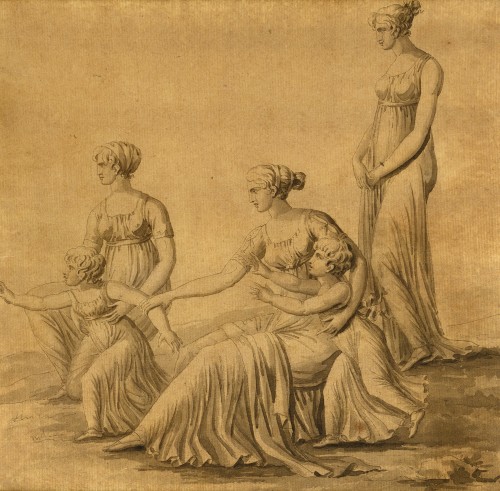Spanish Old Master Drawings
The French Imperial Princess, wife of Joseph I Bonaparte, Marie Julie Clary, and her two daughters Zenaida and Carlota Bonaparte, with two ladies-in-waiting
Alexandre-Hyacinthe Dunouy
(Paris, 1757-Jouy-en-Josas, 1841)
- Date: c. 1806
- Pen and grey ink washes, on laid paper
- 176 X 189 mm
- Provenance: Collection of Queen María Cristina of Borbón and Borbón; collection of the ducal house of Sánchez-Toca; Almería, Antonio Moreno Martín collection; and by descent
Literature: Dibujo español. Del Renacimiento a Goya. La colección de la reina María Cristina de Borbón. Zaragoza, Diputación de Zaragoza, Cajalón, 2008, vol. II, pp. 406-407, cat. no. 126
On March 18 1798, Joseph Bonaparte, brother of the then First Consul Napoleon Bonaparte, acquired the castle and park of Mortefontaine, located in the Oise Department, in the Region of Hauts-de-France.1 From that moment until 1814 this place became the country residence of Joseph Bonaparte, where he hosted many important parties and other social and political events. In 1800, the Treaty of Mortefontaine that sealed the friendship between France and the United States was signed there. That same year, it hosted the wedding of Joachim Murat and Carolina Bonaparte. In 1802, the preliminary talks of the Peace Agreement of Amiens took place in the castle. The predilection that Joseph Bonaparte felt for this place led him to embellish the enormous park in which the castle was located by building a dozen constructions: bridges, towers, ruins, etc. which would add livelihood to the place, following the English fashion.2 His wife, Julie Clary, lived almost permanently in the castle of Mortefontaine due to her fragile health.
read more
For this reason, when José Bonaparte was appointed in 1806 King of Naples and later on, in 1808, King of Spain, she remained in Mortefontaine, defending the interests of her husband. It is in 1806, right before Joseph Bonaparte leaves for Naples, that he orders from the landscape painter Alexandre-Hyacinthe Dunouy two views of the park that surrounded the castle of Mortefontaine3 (figs. 1 and 2, Private Collection), in which his family appears portrayed.
Dunouy started his painting career in Paris in the 80s of the XVIII century. He then left for Italy and started to create views of Rome and Naples, showing a special taste from that moment on for the Italian-style landscapes. In fact, the first work he presented in the Paris Fair of 1781 was an Italian view. The success he reached in that fair with his compositions brought him official orders. In the first decade of the XIX century, Dunouy received numerous requests to paint views of rural farms close to Paris. Among them, he recreated the Château of Fontainebleau of Empress Josefine and the park of the Château of Mortefontaine of Joseph Bonaparte, mentioned before.
Starting in the XVIII century, parks had been acquired for the castles of Ermenonville, Malmaison, Montmorency, Mortefontaine and Saint-Cloud with the aim of transforming them, following the English style, into natural views with pinturesque spots. The two views created by Dunouy of the park of the Castle of Mortefontaine exemplify the French ideal landscape of the time and they show the influence of the paintings created in Italy almost two centuries before by the also French authors Claude Lorrain and Nicolas Poussin. In their works, the landscape has a preeminent role but there were always figures present, human or allegorical, that provided a reason for the painting. This is also the case in Dunouy’s works. His education as a history painter often led him to include figures in his paintings. In this case, in both views of the Castle of Mortefontaine, Dunouy introduces the family of Joseph Bonaparte, which includes his wife Julie Clary and their two daughters Zenaida and Charlote, both very young at the time. The drawing we present here was created for this portrait and it reveals the exact location of the characters in the canvas (see fig. 19. It show a clearly neoclassical composition structure, inserting the figures in a triangle. The Princess, her daughters and ladies-in-waiting wear elegant Empire-waist dresses, following the fashion of the time.
[1] Dubois (1985), p. 20.
[1] Dubois (1985), p. 21.
[1] Miller (2013), p. 15.


